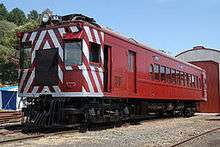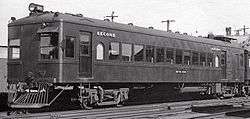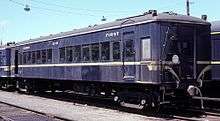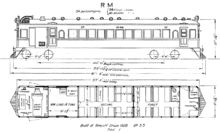Diesel Electric railmotor (VR)
The Diesel Electric Rail Motor (DERM) was a railmotor operated by the Victorian Railways of Australia.
| Diesel Electric Rail Motor (DERM) | |||||||||||||||||||
|---|---|---|---|---|---|---|---|---|---|---|---|---|---|---|---|---|---|---|---|
58RM at Newport Workshops | |||||||||||||||||||
| |||||||||||||||||||
| |||||||||||||||||||
| |||||||||||||||||||
| |||||||||||||||||||


History
Originally built as a petrol electric rail motor, they were the longest-lived rail motor on the Victorian Railways, with the first entering service in 1928 and the last being withdrawn in 1991. They were built by the Newport Workshops to a design of the St. Louis Car Company, and powered by a 220 hp (160 kW) Winton Motor Carriage Company petrol engine, until those were replaced in the 1950s by twin diesel-electric engines, with a power output of 255 bhp (190 kW).
A DERM, with a DERM Trailer car attached, ran a regular passenger service on the South Gippsland line in the 1960s and 1970s. By the 1970s, the longest scheduled journey run by a DERM was the Bendigo to Robinvale run, last operated on 3 June 1978.[1]
In 1976, RM 56 was fitted with a new seating arrangement, including rotating seats, using components from the Z carriage fleet. Capacity was reduced to 34 passengers, because the new seating arrangement was two either side of the central aisle rather than the previous two and three. The first-class end of the vehicle was moved towards the centre, closer to the engine, but providing a smoother ride by averaging the suspension of both bogies rather than just one.[2] The trial arrangement was used on the Yarrawonga line, but patronage did not increase sufficiently to justify the retention of that service.[3]
Following the changes to 56RM, 55RM and 61RM were extensively modified in the late 1970s, with the engines relocated, the body extended, and a new seating arrangement provided.[4][5] The most obvious external difference was the fitting of aluminium-framed windows on the driver's cabin, and porthole windows for the engine room.[6][7] These "Super DERMs" were a familiar sight on the adjoining Mornington and Stony Point lines prior to the early 1980s.
Details of vehicles
Motor units
| Railmotor[8] | Entered service | Upgraded to DERM | Withdrawn | Current owner | Current allocation | Current status | Notes |
|---|---|---|---|---|---|---|---|
| 55RM "Super DERM" | 1928-03-07 | 1952-10-27 | 1993 | VicTrack Heritage | Allocated to Yarra Valley Railway[9][10] | Under Restoration | "Super DERM"; formerly at South Gippsland Railway |
| 56RM | 1930-03-29 | 1952-08-29 | VicTrack Heritage | Steamrail Victoria, Ballarat | Pending restoration | Upgraded interior pre Super DERM program | |
| 57RM | 1930-04-16 | 1952-12-30 | 1982 | Scrapped | |||
| 58RM | 1930-05-03 | 1952-05-10 | VicTrack Heritage | Allocated to Diesel Electric Rail Motor Preservation Association of Victoria | Preserved; operational | ||
| 59RM | 1930-05-14 | 1953-05-23 | Diesel Electric Rail Motor Preservation Association of Victoria | Diesel Electric Rail Motor Preservation Association of Victoria | Supply of spare parts | Formerly with Mornington Railway, transferred September 2015 | |
| 60RM | 1930-06-18 | 1951-10-29 | Diesel Electric Rail Motor Preservation Association of Victoria | Diesel Electric Rail Motor Preservation Association of Victoria | Pending restoration | Stored at Newport Workshops | |
| 61RM "Super DERM" | 1930-06-21 | 1953-10-29 | 1978 | Victorian Goldfields Railway | Victorian Goldfields Railway | Preserved; operational | "Super DERM" |
| 62RM | 1930-07-21 | 1952-01-26 | Daylesford Spa Country Railway | Daylesford Spa Country Railway | Stored; Pending restoration | ||
| 63RM | 1930-08-07 | 1952-12-06 | Daylesford Spa Country Railway | Daylesford Spa Country Railway | Preserved; operational | ||
| 64RM | 1931-04-27 | 1952-07-26 | Diesel Electric Rail Motor Preservation Association of Victoria | Diesel Electric Rail Motor Preservation Association of Victoria | Under restoration |
Trailers

| Railmotor | Entered service | Withdrawn | Scrapped | Current status | Notes |
|---|---|---|---|---|---|
| 26MT | 1930-04-29 | 1982 | Preserved - Stored? | Daylesford Spa Country Railway | |
| 27MT | 1930-04-29 | 1982 | |||
| 28MT | 1930-10-04 | 1981 | 1981 | ||
| 29MT | 1930-09-26 | 1982 | |||
| 30MT | 1930-09-26 | 1982 |

Preservation
All but one of the DERMs have survived into preservation, with 57RM being the only DERM to have been scrapped. Four are operational, with the remaining five in various conditions, generally as a source of spare parts with long-term restoration in mind.
Of the regular DERMs, 58RM regularly runs tours on the Melbourne and Victorian broad gauge system under Diesel Electric Rail Motor Preservation Association of Victoria,[11] and 63RM runs trips on the Daylesford line with trailer 26MT when appropriate.[12]
55RM is allocated to the Australian Railway Historical Society Museum but was suballocated to the South Gippsland Railway; when the latter closed in 2016, it moved to the Yarra Valley Tourist Railway;[13] and 61RM operates on the Victorian Goldfields Railway between Maldon and Castlemaine.[14]
References
- Banger, Chris (March 1997). "Rail Passenger Service Withdrawals Since 1960". Newsrail. Australian Railway Historical Society (Victorian Division). 25 (3): 77–82.
- Diagram D-4, 7th October 1976, available at http://www.victorianrailways.net/motive%20power/diagrams/dermdia.jpg
- https://www.railpage.com.au/f-p92512.htm#92512
- Bray, Vincent & Gregory, Preserved Rolling Stock of Victoria, 2013, ISBN 978-0-9806806-4-5, p.62
- http://www.dermpav.net.au/Surviving-EMC-Railcars/surviving-emc-railcars.html
- "55RM". DERMPAV. Retrieved 28 June 2017.
- "61RM". DERMPAV. Retrieved 28 June 2017.
- "Surviving E.M.C. Railcars - DERMPAV". DERMPAV.net.au. Retrieved 1 November 2016.
- https://www.facebook.com/YarraValleyRailway/photos/a.291974420901885.59883.291969427569051/1115703191862333/?type=3&comment_id=1117184121714240&comment_tracking=%7B%22tn%22%3A%22R1%22%7D
- http://www.yvr.org.au/rm55-has-a-new-home-at-the-yvr/
- http://www.dermpav.net.au/
- http://www.dscr.com.au/
- https://www.facebook.com/YarraValleyRailway/photos/a.291974420901885.59883.291969427569051/1115703191862333/?type=3&comment_id=1117184121714240&comment_tracking=%7B%22tn%22%3A%22R1%22%7D
- http://www.vgr.com.au/stockrailmotors.php